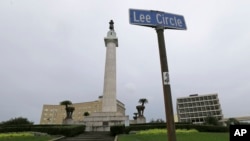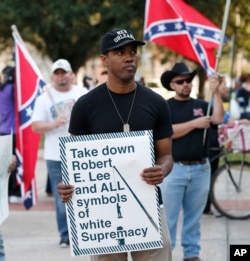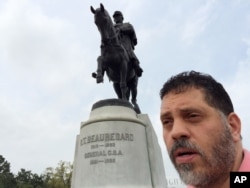Backlash against a plan to remove prominent Confederate monuments in New Orleans has been tinged by death threats, intimidation and even what may have been the intentional torching of a contractor's Lamborghini.
For now, at least, things have gotten so nasty the city hasn't found a contractor willing to bear the risk of tearing down the monuments.
Initially, it appeared the Civil War-era monuments would be removed quickly after the majority black City Council on Dec. 17 voted 6-1 to approve the mayor's plan to take them down. The monuments have long been viewed by many here as symbols of racism and white supremacy.
The backlash is not surprising to Bill Quigley, a Loyola University law professor and longtime civil rights activist who's worked on behalf of a group demanding the monuments come down.
The South has seen such resistance before, during fights over school integration and efforts in the early 1990s to racially integrate Carnival parades in New Orleans.
”Fighting in the courts, fighting in the legislature, anonymous intimidation,'' Quigley said. “These are from the same deck of cards that are used to stop all social change.''
New Orleans is a majority African-American city, although the number of black residents has fallen since 2005's Hurricane Katrina drove many people from the city. Mayor Mitch Landrieu, who proposed the monuments' removal, rode to victory twice with overwhelming support from the city's black residents.
Nationally, the debate over Confederate symbols has become heated since nine parishioners were killed at a black church in South Carolina in June. South Carolina removed the Confederate flag from its statehouse grounds in the weeks after, and several Southern cities have since considered removing monuments.
“There is no doubt that there is a huge amount of rage over the attack on Confederate symbols,'' said Mark Potok with the Southern Poverty Law Center, an Alabama-based group that tracks extremist activity.
His group counted about 360 pro-Confederate battle flag rallies across the nation in the six months after the church shootings. Such rallies were rare before then, he said.
Ugliness, threats, outrage
In New Orleans, things have turned ugly. In early January, as it beat back legal challenges seeking to stop the removal, the city hired a contractor to remove the monuments.
But H&O Investments LLC soon pulled out of the job, citing death threats, “unkindly name-calling,'' outrage on social media and the threat of other businesses canceling contracts.
One day, several protesters came while H&O workers took measurements. Some of the protesters wore materials “with affiliation to white supremacy groups,'' said Roy Maughan Jr., a lawyer for the contractor.
That same day, Maughan said, “a specific articulated threat'' was phoned into city authorities warning workers at the monuments to leave for their safety.
Then, on Jan. 19, a Lamborghini belonging to the owner of H&O Investments was set on fire.
The FBI and local fire investigators declined to comment. No arrests have been made.
After H&O withdrew, the city opened a public bid process to find a new contractor and things got messy again. When the names of companies interested in the work turned up on a city website, businesses were reportedly hit with emails and telephone calls denouncing their involvement.
Michel-Antoine Goitia-Nicolas is one supporter of the boycotts, making calls and joining protests on behalf of the monuments.
“Our lesson in history is that when we tear down the monuments of the past, we rebuild the errors of our past,'' he said.
Just this month, a state lawmaker began pushing a bill meant to save the monuments. Legal challenges, too, are on appeal.











